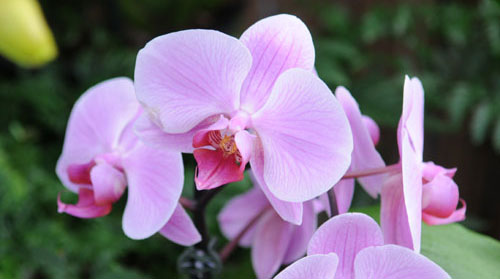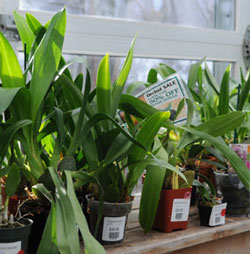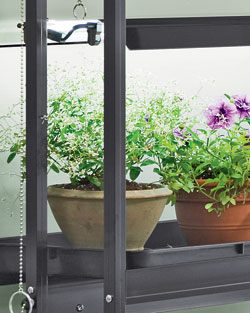

Pay attention to light, water and fertilizer and your phalaenopsis will rebloom.
WHEN it comes to orchids, phalaenopsis (moth orchids) are among the easiest to grow. Blooms last for several months and you can get them to rebloom without a lot of effort. Well, some folks can. I haven’t had good luck getting another bloom, and I have the shelf of non-blooming phalaenopsis to prove it. Frankly, I’m a little bit embarrassed. How do I get my orchids to bloom again?

When they’re not in bloom, orchids are often put on sale at garden centers.
In an effort to improve my success, I checked in with our orchid expert at Gardener’s Supply, Anita Nadeau. She helps customers in the conservatory at our Williston, VT, store. Here are her tips for getting phalaenopsis to rebloom:
Pay attention to watering and humidity. If you neglect your phalaenopsis, it will not reward you with blooms. The plants are probably growing in a free-draining blend of fir bark, so you need to water regularly. Don’t let the roots dry out completely between waterings. Most homes are quite dry during the winter, but you can increase the humidity by setting the orchid pots on a tray of pebbles or a special humidity grid. Make sure the pots are not sitting in the water; they should be just above it.
Fertilize regularly. A fertilizing routine is just as important as a watering routine. Anita recommends feeding orchids with water-soluble fertilizer that’s formulated for orchids. Mix at the rate recommended on the package.

If you don’t have a sunny window, you can ensure proper lighting with a grow light.
Make sure plants get enough light—but not too much. Anita says, “When a healthy orchid does not flower, it is usually due to not enough light.” Phalaenopsis thrive in bright light, but not direct sun. This means east- or west-facing windows are best. If you can’t provide adequate natural light, orchids will also thrive under
full-spectrum lights.
Provide cool nights. Most orchids thrive best when there is a marked drop in temperature at night, usually about 10 to 15 degrees F. Phalaenopsis are more forgiving in this respect, but a reluctant plant can usually be coaxed into bloom more easily if it’s grown where nights are cool.
Tips from Our Blog
When we wrote about orchids in our blog, Gardener’s Journal, we got several good tips from readers:
- “I grow both phalaenopsis and dendrobiums inside, in orchid bark mix and have no problem getting them to bloom. I never let them dry out and I use a weak fertilizer (the one for African violets) every time I water. I do not even have them setting on wet pebbles. They don’t bloom all the time but when they do it’s like someone just gave birth! I have one that is blooming for the third time on the same stem — after the blooms die, I cut just above the first bloom node. Be patient.”
- “I have a large collection of phalaenopsis with about half of them blooming at any one time. They sit above my kitchen sink where they get lots of steam and bright light, but not direct sun.”
- “Join the American Orchid Society and get all the information and support you need to grow every orchid imaginable.”
- “I was talked into growing orchids by my niece several years ago. I discovered my little lean-to greenhouse was a perfect place for them. They receive filtered southeast light. I feed them a constant feed solution of orchid food. I use a mix of orchid bark, sphagnum moss, and just a touch of potting soil. I water when dry.”
- “Oddly enough my phalaenopsis orchids are blooming away in a north window in my home. It is, however, over my kitchen sink so I think the moisture has a lot to do with it. The other thing I found works very well (and takes the guesswork out of it) is the bark mix with fertilizer already in it. Also, the kitchen temp ranges from 48 to 70 degrees F. at best. You never know!”
- “I rescued my phalaenopsis from a grocery store, where it was crammed into a tiny plastic pot, its roots sprawling all over the outside of the pot and the growing medium covered in mold and sprouting weeds, I repotted it in a much larger container with with good-quality bark, and … it has rewarded me with blooms twice a year, since. It sits on the windowsill over my kitchen sink, in a southern-facing window, and temperatures ranging from 55 to 95 degrees F., and it seems deliriously happy! It now has eight huge leaves, and just this month has erupted with not just one but three new branches that grow measurably each day. I water it once or twice a week with a very weak orchid fertilizer solution — the imitation-wood pot has a drain hole about 1/4″ up from the bottom, and I suspect that’s a big help. But for all the delicate beauty of its blooms, this is the sturdiest, healthiest houseplant I’ve got!”
- “I have dozens of orchids. I found that if I put the pot in an old fish bowl they continue to bloom all year. I just put the whole pot in the bowl that has stones in the bottom. I also have found that orchids hate to be moved, so where I put them, they stay.”
SOURCE:/how-to/getting-orchids-to-bloom-again/7241.html